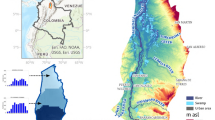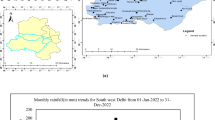Abstract
Check dams are often constructed across the rivers to store excess runoff and to improve groundwater recharge. Quality of groundwater around the check dam depends on the chemical and biological characteristics of the water stored in the check dam. The aim of this study is to determine the benefits due to changes in chemical and microbial composition of groundwater during the process of recharge. This study was carried out in and around a check dam constructed across Arani River, Tamil Nadu, India, where people depend on groundwater reserves for domestic and irrigation requirements. Water samples were collected from the river and surrounding wells and were analysed for chemical and microbial contents. WQI based on the chemical composition indicates that the groundwater was good in this area, but microbes such as Escherichia spp., Salmonella spp., Shigella spp. and Clostridium spp. were present. However, the microbial quality of groundwater is far better than the water stored in the check dam. Hence, production wells can be planned at a distance of about 400 m in the east so that the bank filtrate will take at least 60 days to reach the well. This will considerably reduce the microbial load and also the cost of post-treatment. Thus, river bank filtration may be adopted near the check dams so as to maximise well yield and to achieve natural filtration. This will also enable to use a portion of water that otherwise would be lost due to evaporation from the dam.





Similar content being viewed by others
References
Akkaraboyin MK, Raju BSN (2012) Assessment of water quality index of River Godavari at Rajahmundry. Univ J Environ Res Tech 2(3):161–167
Alam M, Pathak JK (2010) Rapid assessment of water quality index of Ramganga River, Western Uttar Pradesh (India) using a computer programme. Nat Sci 8(11):1–8
Al-Khatib IA, Arafat HA (2009) Chemical and microbiological quality of desalinated water, groundwater and rain-fed cisterns in the Gaza strip, Palestine. Desalination 249:1165–1170
APHA (1998) American Public Health Association, American Water Works Association, and Water Environment Federation. Standard methods for the examination of water and wastewater. American Public Health Association, Washington
Aydin A (2007) The microbiological and physico-chemical quality of groundwater in West Thrace, Turkey. Polish J Environ Stud 16(3):377–383
Bhagavan S, Raghu V (2005) Utility of check dams in dilution of fluoride concentration in groundwater and the resultant analysis of blood serum and urine of villagers, Anantapur District, Andhra Pradesh, India. Environ Geochem Health 27(1):97–108
BIS (Bureau of Indian Standards) (2012) Indian standard drinking water specification, second revision ISO: 10500:2012, Bureau of Indian Standards. Drinking Water Sectional Committee, FAD 25, New Delhi
Brindha K, Elango L (2011) Hydrochemical characteristics of groundwater for domestic and irrigation purposes in Madhuranthakam, Tamil Nadu, India. Earth Sci Res J 15(2):101–108
Brindha K, Elango L (2012) Impact of tanning industries on groundwater quality near a metropolitan city in India. Water Resour Manag 26(6):1747–1761
Cappuccino JG, Sherman N (2001) Microbiology: a laboratory manual. Benjamin Cummings Publishing, Tempe
Clancy JL, Stendahl D (1997) Ground water or surface water—microscopic evaluation of an Ontario River well system. Proceedings of the American Water Works Association Water Quality Technology Conference. Denver, CO, American Water Works Association
David SN, DeWiest RJM (1966) Hydrogeology. Wiley, New York, p 463
Dillon PJ, Miller M, Fallowfield H, Hutson J (2002) The potential of riverbank filtration for drinking water supplies in relation to microcystin removal in brackish aquifers. J Hydrol 266(3–4):209–221
Freeze RA, Cherry JA (1979) Groundwater. Prentice Hall Inc, New Jersey, p 604
Garrity GM, Brenner DJ, Krieg NR, Staley JT (eds) (2009) Bergey’s manual of systemic bacteriology, volume 2, 2nd edn. Springer, New York
Gollnitz WD, Cossins F, DeMarco J (1997) Impact of induced infiltration on microbial transport in an alluvial aquifer. Proceedings of the American water works association water quality technology conference. Denver, CO, American Water Works Association
Hertig AW, Gleeson T (2012) Regional strategies for the accelerating global problem of groundwater depletion. Nat Geosci 5:853–861
Hiscock KM, Grischek T (2002) Attenuation of groundwater pollution by bank filtration. J Hydrol 266(3–4):139–144
Knorr N (1937) Die schutzzonenfrage in der trinkwasserhygiene [protection zones in drinking water hygiene]. Gas Wasserfach 80:330–35
Lloyd JW, Heathcote JA (1985) Natural inorganic hydrochemistry in relation to groundwater. Clarendon, Oxford
Locas A, Barthe C, Margolin AB, Payment P (2008) Groundwater microbiological quality in Canadian drinking water municipal wells. Can J Microbiol 54(6):472–478
Massoud MA (2012) Assessment of water quality along a recreational section of the Damour River in Lebanon using the water quality index. Environ Monit Assess 184:4151–4160
Mudrakartha S (2003) Augmenting groundwater resources by artificial recharge at Aravalli Hills. Gujarat, India. Online at: http://r4d.dfid.gov.uk/PDF/Outputs/Water/R8169-VIKSAT_INCEPTION_REPORT12_May_04.pdf
Niranjan V, Srinivasu VK (2012) Small water harvesting and artificial recharge interventions in Singoda river basin, coastal Saurashtra: hydrological and socio-economic impacts. Report-Institute for Resource Analysis and Policy, Hyderabad
Palanisami K, Raviraj A, Thirumurthi S (2006) Artificial recharge in hard rock areas of Coimbatore District—a case study. International conference on groundwater sustainable development problems, perspectives and challenges (IGC-2006). Online at: http://jnuenvis.nic.in/publication/IGC %202006%20Abstracts.pdf
Parimalarenganayaki S, Elango L (2014) Impact of recharge from a check dam on groundwater quality and assessment of suitability for drinking and irrigation purposes. Arab J Geosci 7(8):3119–3129
Parimalarenganayaki S, Prock J, Yu L, Wintgens T, Elango L (2014) Microbiological quality of groundwater and surface water in a part of Arani River basin, Tamil Nadu, India. In: Prasad NBN, Harikumar PS, Gopinath EJJG, Resmi TR, Surendran U, Ambili GK (eds.) Proceedings of international symposium on integrated water resources management, CWRDM, Kozhikode, India, vol. 1, pp. 415–424
Pius A, Jerome C, Sharma N (2012) Evaluation of groundwater quality in and around Peenya industrial area of Bangalore, South India using GIS techniques. Environ Monit Assess 184:4067–407
Ray C, Melin G, Linsky R (eds) (2002) Riverbank filtration: improving source water quality. Kluwer Academic Publishers, Dordrecht
Sakthivadivel R (2007) The agricultural groundwater revolution: opportunities and threats to development and the groundwater recharge movement in India. Chapt 10. Vol. 3. In: Giordano M, Villholth KG (eds) Comprehensive assessment. CABI Publ, Wallingford, pp 195–210
Sandhu C, Grischek T, Kumar P, Ray C (2011) Potential for riverbank filtration in India. Clean Tech Environ Policy 13:295–316
Sawyer CN, McCarty PL (1978) Chemistry of environmental engineering, 3rd ed. Series in water resources and environmental engineering. McGraw–Hill, New York, p 532
Schijven JF, Rietveld LC (1997) How do field observations compare with models of microbial removal? Under the microscope—examining microbes in groundwater. American Water Works Association Research Foundation and the American Water Works Association, Denver
Umar R, Alam F (2012) Assessment of hydrogeochemical characteristics of groundwater in parts of Hindon–Yamuna interfluves region, Baghpat District, Western Uttar Pradesh. Environ Monit Assess 184:2321–2336
UN Development Programme (1987) Hydrogeological and artificial recharge studies. Technical report number DP/UN/IND-78-029/2, Madras
WHO (2006) Guideline for drinking water quality. Vol. Recommendations. World Health Organization, Geneva, p 130
Acknowledgments
First two authors and the last author thank the Department of Science and Technology’s Funds under the Women Scientist Scheme (SR/WOS-A/ET-49/2010(G)) for funding this work. Partial support from the Department of Science and Technology’s Funds for Improvement in Science and Technology scheme (Grant No. SR/FST/ESI-106/2010) and University Grants Commission’s Special Assistance Programme (Grant No. UGC DRS II F.550/10/DRS/2007 (SAP-1)) is also acknowledged. All authors thank the Centre with Potential for Excellence in Environmental Science scheme of the University Grants Commission (Grant no. F.No.1-9/2004 (NS/PE)) which facilitated this multidisciplinary research work.
Author information
Authors and Affiliations
Corresponding author
Rights and permissions
About this article
Cite this article
Parimalarenganayaki, S., Brindha, K., Sankaran, K. et al. Effect of recharge from a check dam and river bank filtration on geochemical and microbial composition of groundwater. Arab J Geosci 8, 8069–8076 (2015). https://doi.org/10.1007/s12517-015-1825-4
Received:
Accepted:
Published:
Issue Date:
DOI: https://doi.org/10.1007/s12517-015-1825-4




